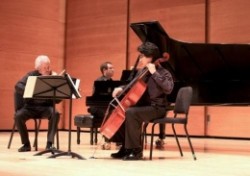|
Acclaim
Weekend opens with Classical Overtures in Distler Performance Hall
 Ashley Seenauth / Tufts Daily
An evening of Arnold Schoenberg and Dmitri Shostakovich may not be the merriest way to start off the weekend, but audience members seemed more than pleased as they filed out of Distler Hall last Friday night.
The classical affair, dubbed "Piano Trios on the Brink," featured two of the heaviest works of 20th century classical music: Dmitri Shostakovich's second piano trio and Arnold Schoenberg's "Transfigured Night." Tufts faculty member Donald Berman played piano, accompanied by Gil Morgenstern on violin and Ole Akahoshi on the cello.
Both pieces use emphatic arrangements and sharp dynamic contrasts to tell stories that mix elation and despair. Shostakovich's piece was written as a celebration of the closing of the Nazi concentration camps in 1945, while Schoenberg's was a musical depiction of two fraught lovers walking through a moonlit park during an emotional breakdown.
The event opened with a unique arrangement of "Transfigured Night." While Schoenberg's original was written for a string septet, the piece played at the event was arranged for a piano trio instead. This completely changed the dynamic of the piece. While the original was lushly orchestrated with rich interplay between the various string instruments, the arrangement on Friday was more focused and intense. The piece's examination of two lovers was reflected more deeply by the violin and cello, whose impassioned melodic lines merged in and out of consonance and dissonance.
Morgenstern and Akahoshi's work on the violin and cello was almost telepathic in its synchronicity. Schoenberg conveyed the shared emotions of the lovers by employing rhythmically identical lines for the string instruments. Both string players were always spot-on with their delivery, maintaining complete rhythmic sync as the melodies themselves slid from octaves and unisons to more dissonant harmonies.
The piece would often segue from such confluent passages to increasingly tense ones, eventually climaxing with a dramatic, discordant segment that quickly came to a romantic resolution. While this pattern took many forms, it persisted through the work as a meditation on the elation and sadness that accompany troubled relationships.
Berman's piano playing was understated but highly effective. The piano plays an almost entirely supportive role in "Transfigured Night," and Berman was capable of molding his playing to the widely various needs of the piece. When the piano did take center stage in a few passages, Berman displayed his talents with much aplomb. Berman played one such segment - a flurry of delicate arpeggios - with such impressionistic finesse that one could have been listening to Debussy.
Once "Transfigured Night" was finished, the group was met with enthusiastic applause, bowing three times before the crowd quieted down. The next piece, Shostakovich's "Piano Trio No. 2," complemented the romantic inflections of "Transfigured Night" in an unexpected way. Shostakovich's melodies were angular where Schoenberg's were curvaceous, and the piece was played with far greater severity than "Transfigured Night."
Once again, the string playing of Morgenstern and Akahoshi was superb, though their talents were displayed in a quite different way in Shostakovich's piece. "Piano Trio No. 2" opens with a very high-registered melody from the cello. Akahoshi's playing was so delicate that one could barely hear the friction between bow and string. His technique imparted the melody with a disembodied, ghostly air that complemented its mournful opening wonderfully.
Shostakovich's usage of dissonance was far more obstinate than Schoenberg's in "Transfigured Night," which made for a more challenging listening experience. Despite the severity of Shostakovich's harmonies, the piece was not without joyous moments. Several pizzicato passages added a playful mood to the piece, as did several percussive piano segments that placed Berman in the spotlight.
Like "Transfigured Night," the emotions of "Piano Trio No. 2" were capable of shifting from despair to uproarious joy within the space of a few bars. Shostakovich's compositional genius made these shifts seem organic despite their abruptness.
Conjuring such disparate emotions in the span of 75 minutes is no small task, but Berman, Morgenstern and Akahoshi succeeded with a seeming effortlessness that made the whole concert a true pleasure to experience — Matthew Welch,
THE TUFTS DAILY
|


 Back to List
Back to List